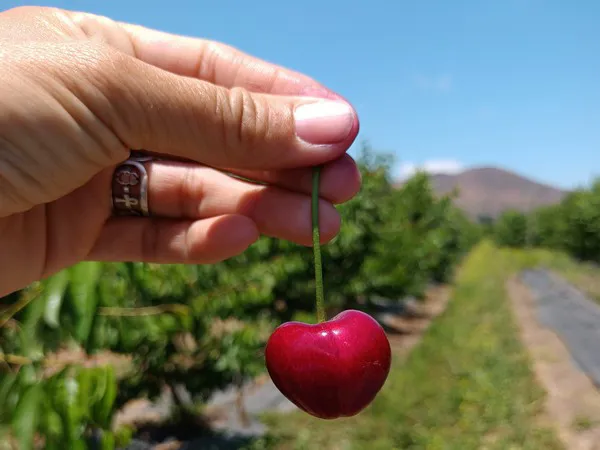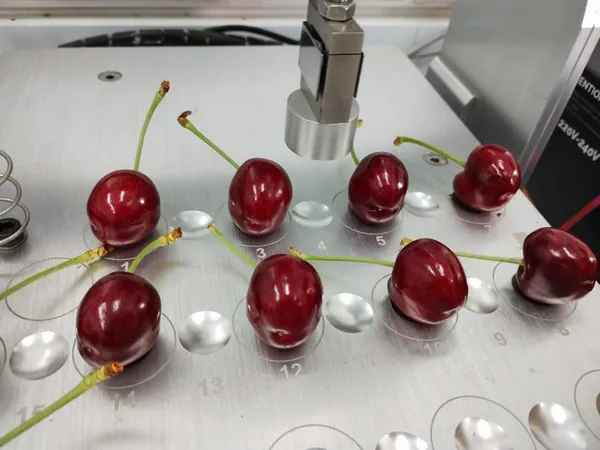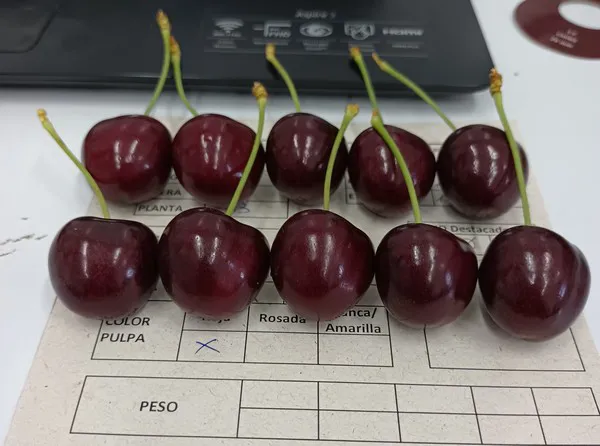“The Chilean sweet cherry industry needs its own varieties. So far, we grow imported varieties only. However, Chile needs new germplasm adapted to our own climatic, logistic and commercial conditions to maintain its competitiveness as main exporter of the Southern Hemisphere,” says Prof. Marlene Ayala, professor and researcher at the Catholic University of Chile.
Prof. Marlene Ayala hosting a recent Field Day to display new cherry varieties in Chile.
She is close to achieving this goal as breeder of new Chilean varieties, with 24 out of 30 advanced selections grafted and under study. Most of Ayala’s career, of over 24 years at the university alone, has been dedicated to work on physiology and general management of deciduous fruit trees. She works very closely with the Chilean sweet cherry growers and exporters.
“I advise them as consultant in specific issues such as innovative planting projects, orchard management practices, product development and research and development on request. An important development project started the year 2010, the “Consorcio Tecnológico de la Fruta” (Fruit Technologic Consortium), composed of the Association of Fruit Exporters of Chile, several export companies and Pontificia Universidad Católica de Chile (PUC), established a traditional genetic breeding program in sweet cherries to generate new cultivars adapted to the Chilean climate and export market. Since then, I have been working on breeding and, to date, we have more than 30 advanced selections grafted and under study. Twenty-four of them have been evaluated for yield, quality and postharvest life.”
Ayala highlights that, besides producing high-quality fruit, new cherry varieties need to adapt to Chile’s climatic conditions. It should be low chilling for areas with warm winter (Central and North areas of Chile). New varieties must tolerate rain and frost and not crack under storage. It must also adapt to the climate change, particularly in terms of tolerance to abiotic stress.
Another crucial aspect is for the new varieties to not only survive but it must be able to handle the logistics chain to far away markets. “Chile needs new early and late varieties to avoid high volume of fruit being harvested and processed during December and early January each season. We harvest most of our commercial orchards (mid-season varieties) in a short and concentrated time, which generates logistics problems in packaging, storage and shipping. Besides, an accumulation of fruit in a short period reduces returns to growers. We need to decentralise our production by promoting fruit production earlier or later in the season, explains Ayala.

She notes markets look out for the following traits. “A new variety for Chile must have a good size (>28 mm), sweetness (>17 Brix) and high firmness (above 85 durofel units). It must be heart shaped, crispness, long pedicel, and dark red in the skin and flesh are important characters also. A very important aspect for Chile is the storage capacity since we are far away from distant markets in Asia. The potential for shipping and storage of a new sweet cherry variety is key for the Chilean industry. Early and late varieties reach higher prices per kg. The best prices are obtained with cherries harvested before Nov 20 and after Jan 30. Currently, early harvest are the most profitable for Chilean growers,” states Ayala.
Varied research work
Besides her focus on sweet cherry breeding the other main areas of her research are sweet cherry physiology and horticultural management. This includes work since 2010 on different training systems associated to high density and pedestrian orchards. Calcium uptake and distribution to increase sweet cherry quality and storage potential. In 2012, she started looking at plastic covers to avoid fruit cracking, but nowadays “we are focused on manipulating harvest time and fruit quality (firmness). Currently, we have physiological and production trials in the Central Valley of Chile, where we are studying the effect of covering on water use efficiency, harvest date and fruit characteristics.”

Dual roles as consultant, researcher and teacher very challenging
“It is very challenging to teach future Chilean horticulturists and the contact with the industry allows enriching my knowledge and expertise, improving my ability to deliver applied knowledge not only to undergraduate and graduate students, but improving my ability to find solutions for daily and strategic problems faced by Chilean growers.”
Areas in which companies need the most help
“In my opinion, Chilean companies need help in innovative field management strategies since sweet cherry yield, quality and storage potential depend on a good horticultural practices. Traditionally we produced cherries in the Central Valley of Chile, but new orchards have been established more to the north and the south of the country. New conditions require adopting different strategies. This is even more important if we consider that the climate change is affecting our orchards, making evident new technological needs associated with emerging biotic (pests and diseases) and abiotic (drought and extreme temperatures) stresses. Besides, companies must continue putting efforts on postharvest technologies since to reach our main market (Asia) is a long trip overseas.”

Meeting needs of current and future market
“My research work has always been linked to solving the problems of the Chilean cherry industry and my career has grown at the speed of the development of the industry. Most of my research grants consider applied research, focusing on finding the basis to solve problems that is either reducing or limiting industry competitiveness. A close relationship with cherry growers and other industry players have allowed that the research and development efforts carried out at the University to be rapidly transferred to growers and exporters,” concludes Ayala.
For more information:
Prof. Marlene Ayala Horticulturist Ph.D
Catholic University of Chile
Tel:¨+56 (9)998 171 046
Email: mayalaz@uc.cl
www.agronomia.uc.cl
